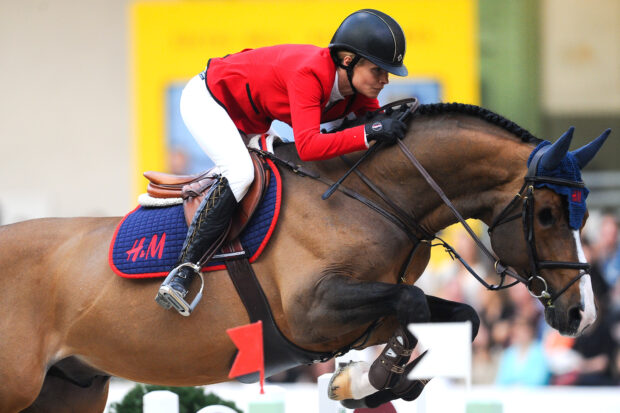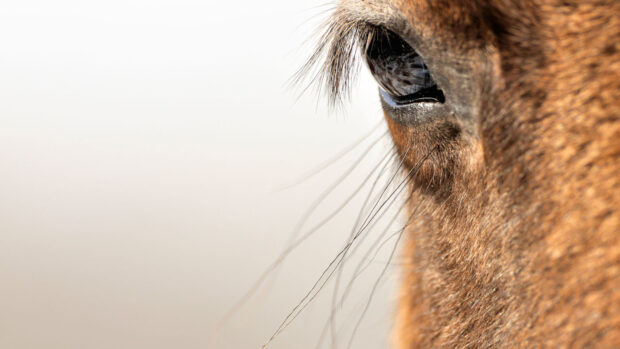It is very difficult to assess a horse’s vision. Currently vets can only detect the most major visual impediments in horses, due to the crudeness of the tools we have available.
An ophthalmoscope is the standard instrument used to look inside a horse’s eye. The first thing a vet looks for is any opacity within the lens. This is seen as a dark area that is not transparent to the bright light being shone into the eye. Basically, any such area of the lens that is not “see-through” is a cataract.
It is thought that some form of opacity is present in about 5-7% of horses with otherwise clinically normal eyes. These may be so tiny that they are only picked up with a detailed ophthalmic examination in a darkened stable. The lack of light makes the horse open its pupil wider, so enabling the vet to see more of the inside of the eye.
Cataracts can be a cause for concern when a horse is examined for purchase by a vet, partly because they may have been previously undetected. Most knowledgeable owners have a pretty shrewd idea of their own horses’ defects. Even so, there is often a sigh of relief when the eyes are declared to be clear at a vetting, simply because the inside of the eye can be one area that remains a mystery.
What if a cataract is found?
Horses with small cataracts show no clinical signs. If one is found, it is sensible to have it rechecked six months to a year later to ensure it has not progressed. Many owners do not bother because treatment is not an option, but I recommend having the eye checked to ensure that the horse is still safe to ride.
Where cataracts are causing a progressive loss of sight, the signs can include:
- stumbling
- walking into objects
- an abnormal number of facial injuries
- an alteration in head carriage
- sudden shying
- increased anxiety and jumpiness
The majority do not progress and are unlikely to affect vision, although some cataracts can be assessed only by repeated examination of the eyes on several occasions over a lengthy period of time.
Treatment
Surgery is the only treatment. The decision on whether to operate depends on the severity and cause of any ongoing eye damage. Surgery should be reserved for the eye that has a cataract and nothing else wrong, so a detailed assessment must be carried out to ensure appropriate selection of patients, and that the owners understand all the risks.
Equine cataract surgery is not something to be undertaken lightly and is best avoided if a horse still has one normal eye. Even if the cataract surgery is successful, the treated horse will never have normal vision.
This challenging surgical procedure is performed only by a few highly skilled and intrepid equine ophthalmic surgeons.
Cataract facts
Cataracts may be:
- Congenital (present at birth), possibly due to problems such as infection, poor nutrition or exposure to toxins while the foal was developing in the uterus
- Hereditary — in some breeds these may be present at birth or develop by the age
of three - Acquired as a result of injury or disease
- The result of ageing changes and either unilateral (affecting one eye) or bilateral (both eyes).
A cataract on its own is not painful, but the eye may be sore if there is other ongoing eye disease, which may have caused the cataract.
Unless a cataract is large, the horse’s owner may be unaware of its existence.
A large cataract may show up as a blue or milky haze within the black pupil. Advanced cataracts may have a yellowish quality, especially if there are other ongoing eye diseases.Although a cataract will not block all the light going into the eye, the affected part of the lens will prevent a meaningful image being produced at that point. Instead, anything in the affected area will look blurred as if seen through dense fog.
Cataracts can range from tiny developmental defects with a minimal effect on vision to extensive cataracts that can affect the usefulness or safety of such a horse.
Cataracts are part of the normal ageing process and occur in all species of domestic animals as well as man. One survey of 83 horses and ponies over 15 years of age showed that 10 animals had cataracts, yet none was reported to have any visual defect.
- This veterinary feature was first published in Horse & Hound (21 July, ’05)

 Get up to 19 issues FREE
Get up to 19 issues FREE UK’s No1 weekly for Horses for Sale
UK’s No1 weekly for Horses for Sale Latest results and reports
Latest results and reports TO SUBSCRIBE CLICK HERE
TO SUBSCRIBE CLICK HERE




